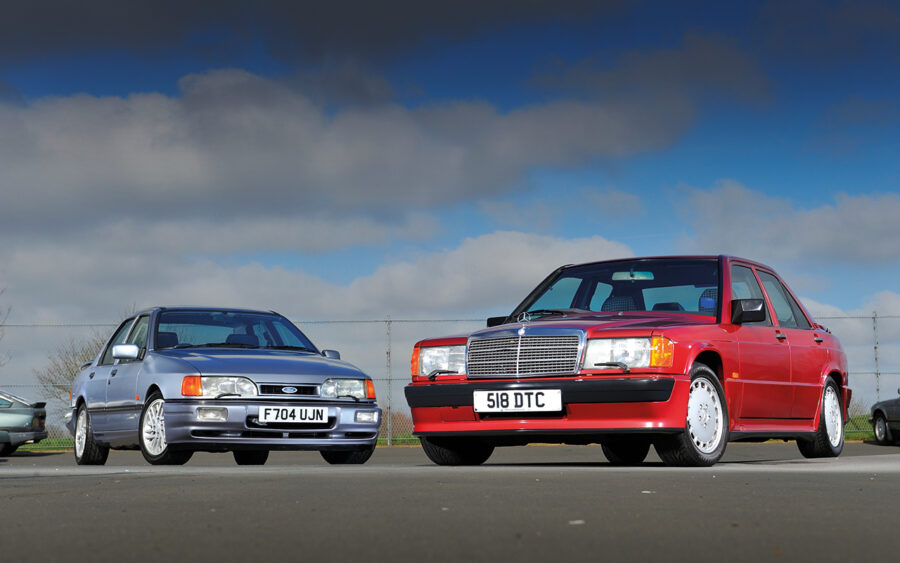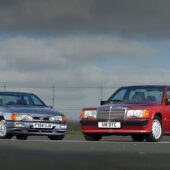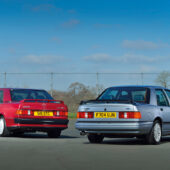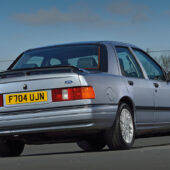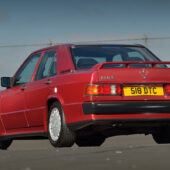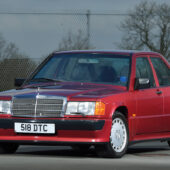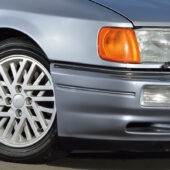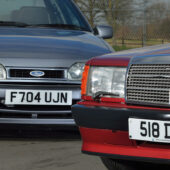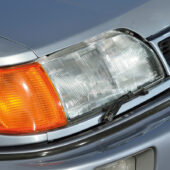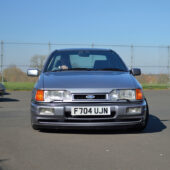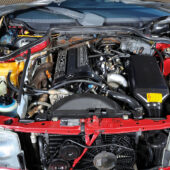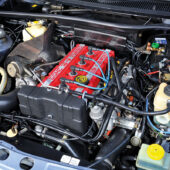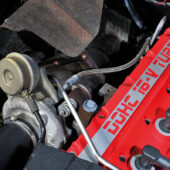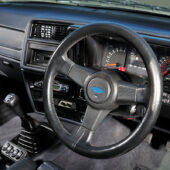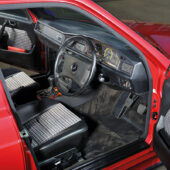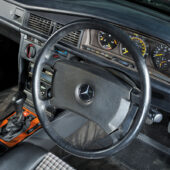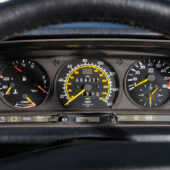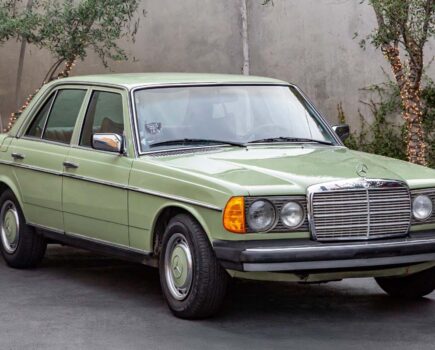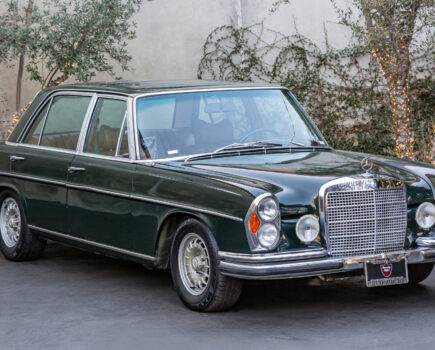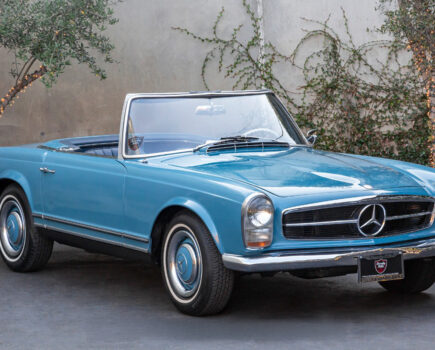While buyers of the Mercedes-Benz 190 2.5-16 might not have considered a Ford Sierra RS in period, the two cars share common Cosworth kinship
Words: Paul Wager Images: Matt Woods
The 1980s was the perfect decade for automotive excess. We might have the Veyron and the McLaren P1 today, but the decade of Thatcher and Duran Duran gave us everything from the Cizeta V16T and Bugatti EB110 to Jaguar XJ220, Metro 6R4, Lancia Thema 8.32, Delta Integrale… and the list goes on. Many of the more outrageous ’80s products were of course driven by the need to homologate certain models for motorsport, and it was this which resulted in the dramatically whale-tailed Ford Sierra RS Cosworth.
The collaboration between Ford and Cosworth created one of the most iconic cars of the decade, while the demands of homologation even saw Mercedes-Benz entering the fray, also enlisting the British Cosworth firm to liven up its new 190E. When the Sierra Cosworth subsequently became the four-door Sapphire Cosworth, the market suddenly had a choice of two sober-looking but brisk road cars; both engineered by Cosworth but both offering a very different driving experience. We sample the pair some three decades later and try to pick a favourite.
Mercedes 190E 2.5-16
Plough your way through the Mercedes press material relating to the ‘W201’ series and there’s a surprising omission: the Cosworth name simply isn’t mentioned. Presumably the mighty Mercedes-Benz didn’t want to admit that in order to extract sufficient power from its M102 powerplant in had to turn to the relatively tiny Northamptonshire engineering firm for a twin-cam four-valve head.
More likely is the suggestion that the go-faster 190E model was such a tiny project that it wasn’t worthwhile diverting the attention of the mainstream powerplant engineering departments and remember, this was the era before AMG became a part of the Daimler-Benz empire.
The story of the Cosworth-powered Mercedes begins with the development of the 190E. Having survived and indeed thrived on making larger cars for most of its history, Mercedes had identified a demand for a more compact car – no doubt inspired by the success of BMW’s ’02 and 3-Series cars plus the looming threat of corporate average fuel economy requirements in the US market – and embarked on a massive development programme.

The brief was that none of the traditional Mercedes values should be compromised in the move to a smaller car and increased fuel efficiency. To this end high-strength steel was used in key areas to achieve the passive safety of the S-Class while weighing in at just 1180kg. The design brief also required handling to be the equal of the bigger cars, a requirement which was in practice exceeded by the use of a five-link rear suspension design and wishbone front end.
The car was launched in December 1982 as the 90 bhp carburetted 190 and 122 bhp Bosch-injected 190E, both powered by the 1997cc M102 engine.
Long absent from motorsport, Mercedes saw its new compact model as an ideal return to the rallying stage where it had once been successful with its larger coupes and so approached Cosworth to develop a suitable engine. With engines like the Ford BDA behind it, the Northamptonshire firm did have an impressive pedigree in the forests and developed a twin-cam head with four valves per cylinder. Bolted on to the 2.3-litre version of the M102 block as used in the W123 series, this was good for up to 300 bhp at 8000 rpm in dry-sumped race trim with individual slide throttles. With conventional intake and wet sump configuration and running Bosch K-Jetronic injection, the roadgoing car was good for 185 bhp at 6000 rpm which translated to a 0-62 mph time of 7.5 seconds and a 143 mph top speed.
Unfortunately for Mercedes, Audi debuted the Quattro in 1980 which with its four-wheel drive rather scuppered Mercedes’ rallying plans. Not wanting even to play if they couldn’t win, the board turned its attention to the German Touring Car championship, the Deutsche Tourenwagen Meisterschaft (DTM) and to prove the new car’s high-speed credentials sent a trio of 190E 2.3-16s to the high-speed Nardo bowl in southern Italy where the cars covered 50,000 km in 201 hours, smashing several high-speed endurance records.
The road car was unveiled a few weeks later at the 1983 Frankfurt show and was a masterpiece of understatement for the era. A distinctive yet subtle bodykit incorporated spoilers front and rear with side skirts and helped reduce the Cd to 0.32 while inside the 2.3-16 featured heavily bolstered Recaro seats and additional dials.

The suspension was modified for the performance flagship too, with lowered and uprated springs, revised damping, chunkier anti-roll bars and hydraulic self-levelling at the rear. A limited-slip diff was standard equipment and to reinforce the car’s racy character a Getrag five-speed box was fitted with a race-style ‘dog leg’ pattern which places first gear over to the left and back, the thinking being that first gear isn’t needed on the track, so the frequently used ratios are in the main H layout.
The 2.3-16 was a contender in the DTM, although Mercedes chose not to enter works racers directly, instead supporting independent teams including AMG. In 1987 though, the decision was taken to re-enter motorsport in a works capacity and accordingly the twin cam M102 motor was further developed, gaining a boost in capacity to 2498cc courtesy of a longer stroke. A duplex timing chain replaced the original single chain and running KE-Jetronic injection it was good for 204 bhp in non-catalysed form.
Like its predecessor it was a low-key production with just the neat bodykit giving the game away. The same couldn’t be said of the Evolution versions which followed, 500 roadgoing examples required to homologate a heavily revised version for Group A of the DTM. The engine was redesigned with a shorter stroke to permit higher revs and chase BMW’s M3 Sport Evolution and the 1989 Evolution road car featured flared arches to house fatter wheels and a bigger rear spoiler. An Evolution II model followed in 1990 which used the same engine but with more extensive bodywork modifications including a tall rear spoiler as outrageous as the original Sierra’s whaletail. It was the Evo II which took the DTM title in 1992 in the hands of Klaus Ludwig.
These cars are rare though and it’s the 2.5-16 which is the more plentiful, certainly in the UK and we found this superb example at well known Mercedes specialist Avantgarde. A 1989 example of the 2.5-litre car it’s a perfect illustration of the appeal of these cars.
Finished in Almandine Red, it looks more executive express than hot rod, with only the boot spoiler and deeper sills to give the game away to the uninitiated. Open the typically hefty Mercedes door though and inside things are immediately rather more overtly sporting. The half-leather Recaro seats feature cloth inserts in the check pattern typical of ’80s Mercedes and the rear seats are similarly sculpted to provide four individual places.

After pausing to find the ignition key on the left of the steering wheel, it’s a surprise to discover just how refined the Cosworth-Mercedes engine is, especially after the Ford unit.
A nice 190E is always a pleasure to drive and the 2.5-16 is even nicer, feeling generally firmer and more positive from behind the wheel. The normally-aspirated engine has a more immediate response than the blown Ford unit and the 2.5-litre engine has a useful torque advantage over the 2.3. The overall feeling is of a kind of grown-up, more serious GTI.
At low speeds the 2.5-16 doesn’t feel much different from the regular 190E and is happy to trundle about around town, but when traffic clears the difference is like night and day. The twin-cam revs much harder than the regular M102 engine and the lag of turbo lag makes it easier to drive hard than the Sierra. The Ford with its all or nothing sudden rush of power may feel more exciting but in truth the in-gear acceleration of the two cars is pretty evenly matched.
As far as handling goes, the two feel very similar, the Mercedes feeling the more secure of the two and tending towards gentle understeer at the limit where the Sierra tends to feel more edgy, as if when it lets go it’s going to bite hard.
Away from the performance question, the general solidity and high quality of the Mercedes is worlds away from the Ford and it’s this which marks it out as being in a different league. The compact W201 may have been a new departure for Mercedes but these cars are from the era when the quality was beyond question and everything feels as if it will last forever. This particular example has less than 70,000 miles showing but feels as if it would be good for several times that before it started feeling its age. And you wouldn’t find yourself saying that about a Sierra…

Ford Sierra Sapphire RS Cosworth
I’ll admit to a slight bias here: as editor of a Ford magazine in the mid ’90s I’ve spent a fair bit of time in and around Sierra Cosworths, most of which were souped up to at least 300 bhp and often as much as 500 bhp or more. On every whistling, wheelspinning white-knuckled ride the owners would have an anecdote about comprehensively shutting down a Porsche or Ferrari and in a nutshell that was the appeal of the turbo Sierra: just as with the racers, the standard production offering was only the beginning, a kind of blank canvas.
All of which means a standard unmodified car is a very rare beast indeed and we were lucky to find this example in stock alongside the Mercedes at Avantgarde.
The comparison between Sierra and 190E Cosworths has been done before of course and in truth they appealed to very different buyers when new but today could both be on the same list for an ‘80s fan looking to acquire a dream car from his teenage years.
The car in question is a 1989 F-registered Sapphire in the popular Moonstone Blue, featuring black leather Recaro interior and the rare optional air conditioning. It’s covered just 22,000 miles which makes it probably unique: a few of the three-doors and RS500s have been preserved in collections but not many two-wheel drive Sapphires.
Like the Mercedes, the Ford Cosworth existed purely for homologation reasons, stemming from Ford’s desire to compete in Group A circuit racing. There had been a long association between Ford and Cosworth and the Northampton firm had already been working on a twin-cam, 16-valve version of the Pinto 2-litre engine. It was this engine in forced induction form which would become the YB engine and an agreement was reached which saw Ford commission Cosworth to produce 15,000 examples, an ambitious target which required a new factory building to turn out 440 engines every month.
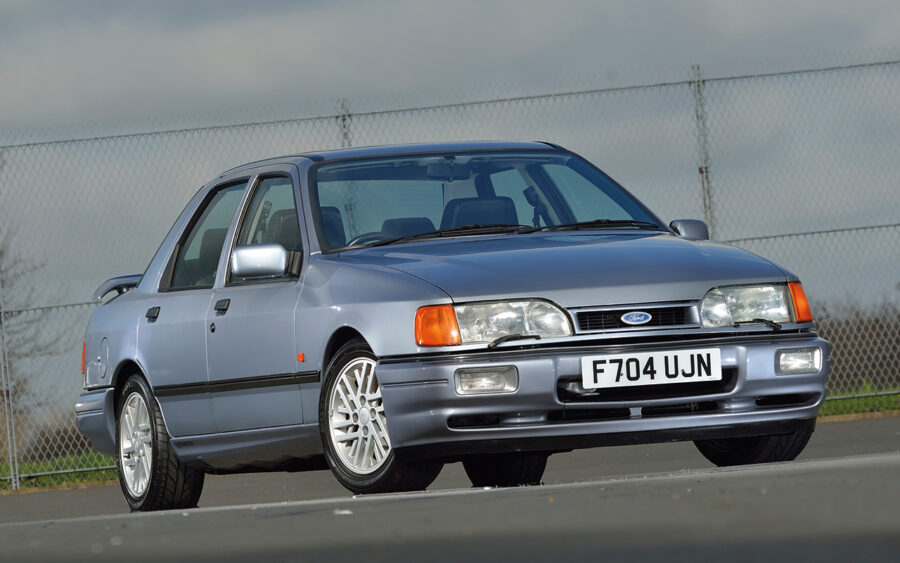
The first appearance of the 204 bhp YB engine was in the Sierra Cosworth of 1986, which stunned the public with its performance: 149 mph and 0-60 mph in 6.5 seconds was supercar stuff for your £16,000.
The same money would have bought you a sober BMW 325i but the Sierra Cosworth wasn’t to everybody’s tastes: keeping the aerodynamic Sierra bodyshell on the road at nearly 150 mph required a massive rear spoiler which became the car’s trademark. The following year saw production of an ‘evolution’ version of the original car as permitted under FIA rules and the result was the RS500. Completed by Aston Martin’s Tickford facility, the RS500 featured an additional lower rear spoiler, an eight-injector setup and additional suspension mounting points as well as a stiffer engine block and bigger Garrett T4 turbo. The RS500 was good for 153 mph and 0-60 in 6.2 seconds but only 500 were made.
Ford made 5542 of the original three-door Cosworth which meant an awful lot of engines left over in that 15,000-unit contract, which explains why the Cosworth engine was installed in the four-door Sierra Sapphire in 1988, providing an equally thrilling drive but in a more sober package which Ford’s marketing men knew would sell in bigger numbers.
And they were right. The Sapphire Cosworth tempted more than a few buyers away from BMW and Audi with its M5 killing performance and affordable price tag. The recipe was further improved in 1990 when Ford added the all-wheel-drive hardware from the XR4x4 and updated the engine with stronger block, revised turbo and intercooler. The result was an increase in power to 220 bhp, although the 4×4 and additional weight blunted top speed to 144 mph and 0-60 was up to 6.6 seconds but the 4×4 was the ultimate evolution of the Cosworth idea. Indeed, its platform would go on to underpin the Escort Cosworth which was in fact more Sierra than Escort.
Like the Mercedes, the Sapphire Cosworth is relatively restrained with only the neat boot spoiler, deeper front and rear bumpers and 15-inch wheels to give the game away. Oh and the Cosworth badging on the boot of course, which the Mercedes does without. It was the Sierra we all wanted back in the ‘80s, even as petrolhead teenagers being only dimly aware of the Mercedes’ existence.

Approaching the Ford after the Mercedes is perhaps unfair since the Sierra was never designed to compete with the 190, so it’s no surprise to find the door catches a little less chunky, the door itself less solid and the interior plastics more, well, plasticky.
Like many turbocharged engines, the Cosworth YB engine lacks a characteristic exhaust note and can sound slightly harsh at idle in the way of a race engine. Driving the Sierra Cosworth is peculiar mix of sensations: half pure repmobile but half serious performance car. The interior is mostly shared with other upmarket Sierras which means an aura of late ’80s minicab, but the driving controls all feel that bit more thought out, more heavily weighted and generally more positive.
Those unfamiliar with the Cosworth and ’80s performance cars in general will find the Cosworth slightly underwhelming for the first few yards, since off boost the YB is no more lively than a standard 2-litre Pinto. As the revs and boost build though, there’s a change in character which culminates in a performance rush at about 3500 rpm when the Garrett blower starts to do its stuff. Keep your foot in and you’ll find the Sierra suddenly comes alive, the turbo engine’s power delivery being exhilarating compared to the Mercedes’ more linear power curve. It all makes the Sierra harder work to drive quickly across country but ultimately more satisfying when you get it flowing properly.
As for the handling, the Cosworth was well tied down compared to regular Sierras and is generally a predictable beast of the rear-drive school complete with standard LSD. It’s less of an understeerer than the Mercedes on the limit though and while this may make it easier to drift at will, it does mean it demands caution in the wet. To compare the two is to compare Essex with Stuttgart, the Ford eager to get itself into trouble and the Mercedes just as capable but tempered with caution.

Mercedes 190 2.5-16 vs Ford Sierra Sapphire RS Cosworth: our verdict
I set out with an admitted bias towards the Ford thanks to familiarity with the Sierra Cosworth and its generally more sporting demeanour but the big surprise is how nice the Mercedes is. It’s easier to drive fast and the sheer quality of the car adds to its enjoyment.
Although the Sierra is faster on paper, the two are pretty evenly matched on the road – which is enough for the 190E 2.3-16 to get my vote.

